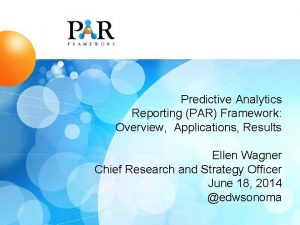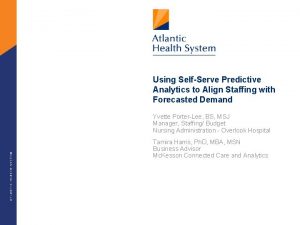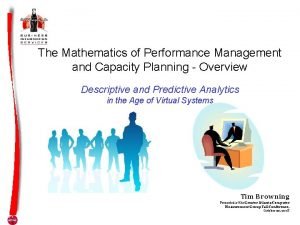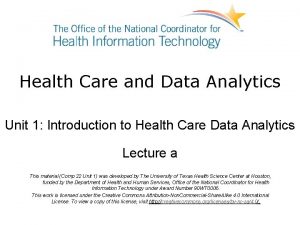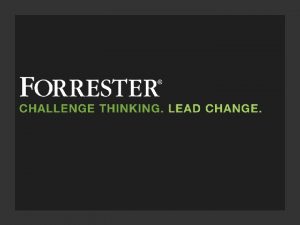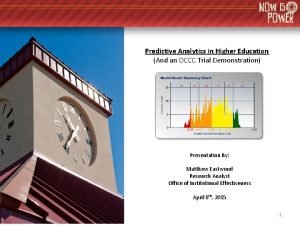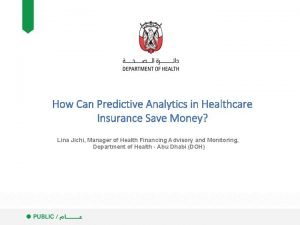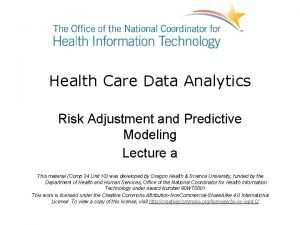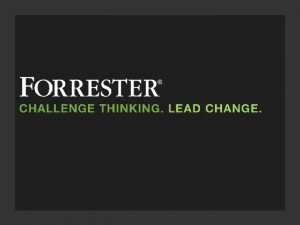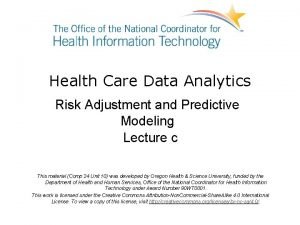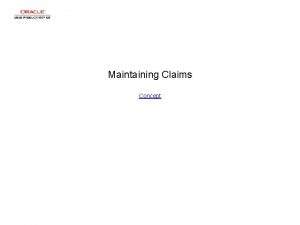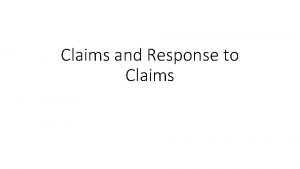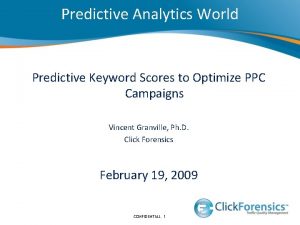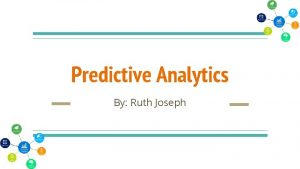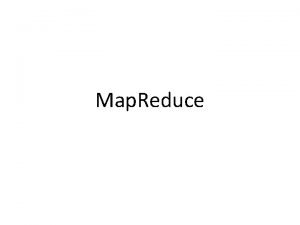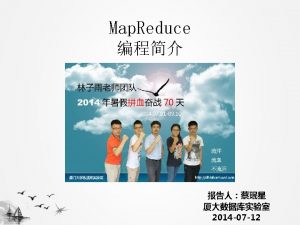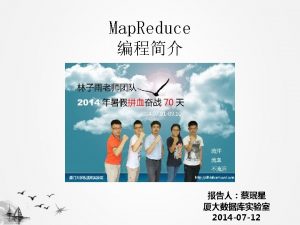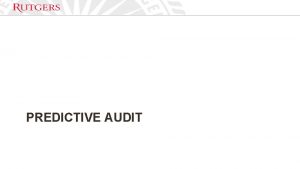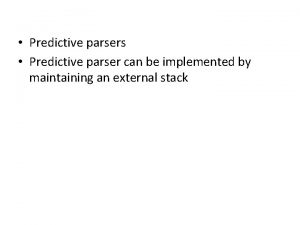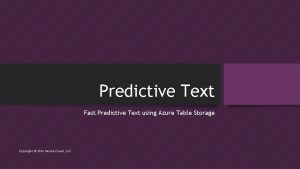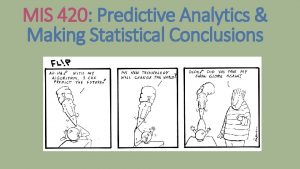Claims Analytics Using predictive analytics can reduce your




















- Slides: 20

Claims & Analytics Using predictive analytics can reduce your costs and improve your profitability Sanjay Jha Insurance and Investments Innovations Forum, 7 th Dec 2017, Dubai 1

Agenda 1. 2. 3. 4. 5. Understanding Analysis & Analytics Insight into Predictive Claim Analytics What are Cost Components in Insurance Business What contributes to Profit Role of Predictive Analysis in improving bottom line 6. Solutions 7. Conclusions 8. Open House 2

Analysis v/s Analytics • Data analysis refers to hands-on data exploration and evaluation. • Data analytics is a broader term and includes data analysis. • Analysis looks backwards over time, providing historical view of what has happened. 3

Analytics Methodologies: • • Descriptive – results capable of being analyzed and synthesized to further benefit the business. Diagnostic – educates customers on when loss can happen and how to reduce the risk. Predictive – anticipates trends. Prescriptive – recommends course of action. 4

Predictive Analytics What it is: • Extracts information from existing data sets. • Combines with customer insight to forecast future probabilities. • Uses data mining, statistical modeling and machine learning. • Predictive models indicate probabilities, not certainties. 5

Predictive Analytics Process: • • Define Project Data Collection Data Analysis Statistics Modeling Deployment Model Monitoring 6

Predictive Analytics in Claims Applications : • • • Assigning claim to an appropriately skilled claims professional. Permit greater accuracy when settling claim & reserve. Identify and alert on important risks and/or mitigation opportunities. Detects patterns of potentially mistaken, fraudulent, wasteful and abusive claims. Identification of Potentially High Value Losses. 7

Predictive Analytics in Claims • Data integrity is essential. • The deeper the history, the better for trending purposes. • (Say) For Health insurance claims, most important variables to predict the claimed amount vary over the statistical methods. Some models need length of stay, age, unemployment rate, education rate, residence area etc as critical while other models need number of hospital services, number of diagnosis in ICD-13, ICD-5 & ICD-10, number of chronic disease, previous claim amount, average payment delay etc. 8

Cost Contributor 1. 2. 3. 4. 5. 6. 7. Acquisition Cost UW Cost Servicing Cost/TPA Fee Claims Payment Claims Reserve/Actuarial Reserve Management/Admn. Cost/Infra Cost Taxes * Use of analytics would favorably impact all but Government Taxes 9

Profit Component Profit is Surplus of Revenue over all Expenses and all Expense Provisions. Revenue sources: A. Premium Income B. Investment Income C. Other Earning Use of analytics would favorably impact product pricing & customer retention thereby increasing premium income & profit margin. It would also help improve cash flow, investment return and other earnings. 10

Claim Analytics and Bottom Line Areas where Claim Analytics can make Big difference: • • Fraud Detection Outlier Claims Subrogation Potential Settlement Values Loss Reserve Defense Strategy Litigation Expense Management 11

Predictive Analytics – Real Solution 1. Data Prep • • Eliminate outliers Impute missing values 2. Variable Reduction • Use Principal Component analysis to identify top 4 most input factors 3. Model Building • Forward Stepwise Regression 4. Model Validation • Perform standard statistical tests on residuals etc. • The Key to successfully applying analytics is to correctly describe the business problem and establish meaningful objectives. • Affordable analytics tools customized for specific needs can be built using a combination of well established Data Analytics Process, Open Source Technology & Cloud Computing. • Whole process may take from few weeks to months • There are many solution providers available in the market. 12

Predictive Analytics – Real Solution Range of Claim Analytics (By one ‘particular’ Solution Provider) Reporting Descriptive Analytics Predictive Analytics Prescriptive Analytics First Notification of Severity Model & Claim Severity Litigation Loss Alert Scoring Model for Projections & Modeling Management Model Reporting Claims Reserve requirements Medical Management Outlier Claims Dashboards Subrogation Modeling Claims Satisfaction Litigation Propensity Dashboards Prediction Model Benefits as claimed by same Solution Provider: • • A UK Based insurer saved £ 2 million annually by implementing claim analytics for Auto Parts. A top global insurer saved $ 3 million annually, utilizing predictive models for subrogation. A Swiss insurer reduced risk of penalties from non-compliance to < 1%. A car insurer increased claims within FNOL from 4% to 25% enabling sharp improvement in LAE. 13

Example (Health) Av Person Claim 140 120 100 80 60 40 2011 - 12 2012 - 13 2013 - 14 2014 - 15 2015 - 16 2017 • Strong correlation found with Group Size & Loss Ratios • Exited from large groups • More focus on medium sized brokers 14

Example (Motor) Motor UW Profits 4, 000 3, 000 2, 000 1, 000 (1, 000) 2006 2007 2008 2009 2010 2011 2012 2013 2014 2015 (2, 000) (3, 000) (4, 000) • Automatic UW with rules based on Make, Model, SA, New v/s Old, Driver’s Age, Geography • Exited from Dealership tie ups • Prices for Renewals, High SA, Old Drivers, Repeat Buyers were made attractive. • Benefits: Higher profit, reduced Treaty rates 15

Example (Non-Motor) Non Motor UW Profits 2, 000 1, 500, 000 1, 000 500, 000 2006 2007 2008 2009 2010 2011 2012 2013 2014 2015 • Reverse flow of Claim information to UW • Moved out of Road Projects, Shopping Malls • Stopped stand alone Liability, Fidelity Guarantee, Money • Benefits: Increase in profit, more homogeneity in treaty performance, increased capacity given by reinsurer, higher RI commission, relaxed RI terms 16

Conclusions • Predictive Analytics in Claims has huge role in improving loss ratios. • Sometimes it is said that a 1% improvement in the loss ratio for a $1 billion insurer is worth more than $7 million on the bottom line. • Utilization of Predictive Modeling with Claims management remains unknown to many. Insurers must assess the implementation requirements of time, money and manpower vis a vis potential benefits. 17

Conclusions However, there are skeptics too. . People are influenced in innumerable ways, all of those variables are unpredictable. How they will impact a person is even less predictable. 18

Questions? 19

Thanks sanjayjha. in@omanutd. com sanjayjha. in@gmail. com 20
 Data insights quotes
Data insights quotes Sap predictive analytics demo
Sap predictive analytics demo Microsoft sql server machine learning
Microsoft sql server machine learning Predictive analytics reporting
Predictive analytics reporting Phases of data analytics life cycle
Phases of data analytics life cycle Predictive analytics staffing
Predictive analytics staffing Knime predictive analytics
Knime predictive analytics Capacity planning and performance management
Capacity planning and performance management Challenges of implementing predictive analytics
Challenges of implementing predictive analytics Predictive prescriptive analytics
Predictive prescriptive analytics Logistic regression vs random forest
Logistic regression vs random forest Forrester wave email marketing vendors 2017
Forrester wave email marketing vendors 2017 Predictive analytics in higher education
Predictive analytics in higher education Predictive analytics in health insurance
Predictive analytics in health insurance Health care risk adjustment and predictive modeling
Health care risk adjustment and predictive modeling Forrester wave email marketing vendors 2017
Forrester wave email marketing vendors 2017 Forward looking perspective
Forward looking perspective Health care risk adjustment and predictive modeling
Health care risk adjustment and predictive modeling Claims and counterclaims examples
Claims and counterclaims examples Effective persuasive claim letters
Effective persuasive claim letters Using citys heat reduce emissions
Using citys heat reduce emissions



